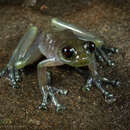Description
provided by AmphibiaWeb articles
Diagnosis: This species can be diagnosed from all other centrolenids by the following combination of characters: vomerine teeth present; snout protruding in lateral view and truncated in dorsal view; slightly elevated nostrils with depressed internarial region; concave loreal region; distinct, dorsolaterally oriented tympanum; very weak supratympanic fold; dorsum slightly shagreened; venter coarsely areolate; a few low tubercles are present around cloacal opening, but subcloacal area is lacking tubercles or other ornamentation; transparent parietal and visceral peritoneum translucent, except for pericardium which is covered by iridophores; liver trilobate; males lack humeral spine; basal webbing between Fingers I and II, webbing for outer fingers II 1−–3 III 2−–1IV; webbing for toes I 1−–1 II 1−–1− III 1−–1− IV 1–1 V; hands, upper arm and feet lacking dermal folds and tubercles; ulnar and tarsal folds present; males with concealed prepollex and unpigmented Type I nuptial pads; Finger I longer than Finger II; eye diameter larger than width of Finger III disc; bright green dorsum in life; green bones; in preservative, dorsum is deep gray-purple with some blurry cream-colored spotting; iris golden copper with some dark reticulation; fingers and toes have melanophores; males call from upper side of leaves and ferns, near small streams; SVL 20.4-21.3 mm in females and 19.0 mm in single male specimen (Cisneros-Heredia et al. 2009).Description: Females measure 20.4-21.3 mm SVL; a single male measured 19.0 mm SVL. Slender body with head wider than body. Snout protrudes in profile and is truncated when viewed from above. Nares are slightly raised. Canthus rostralis is indistinct. Loreal region is concave. Lips are flared. Eyes are large and protuberant. Tympanic annulus is visible. Weak supratympanic fold runs from the eye to the arm insertion. Vomerine teeth present. Humeral spine absent. Ulnar fold present. Fingers are webbed, but webbing is basal between Fingers I and II. Fingers have slightly expanded truncated discs. Finger III discs are slightly larger than toe discs. Finger III is longest. Bulla absent. On fingers, subarticular tubercles are raised and rounded. Supernumerary tubercles present but indistinct. Palmar tubercle is large and rounded; thenar tubercule indistinctly elliptical. Slender hind legs. Tarsal fold present. Toes are webbed and have truncated, slightly expanded discs. Inner metatarsal tubercle is large, flat, and oval-shaped. Outer metatarsal tubercle is indistinct. On toes, subarticular tubercles are rounded while supernumerary tubercles are small and indistinct. Skin shagreened dorsally, coarsely areolate ventrally. Cloacal ornamentation absent except for small low tubercles around the cloacal opening. Subcloacal tubercles are absent. Males have Type I unpigmented nuptial pads and concealed prepollices (Cisneros-Heredia et al. 2009). Coloration uniform bright green, shading to yellowish toward the flanks. Upper eyelids may be yellow-green or bright green. Digit tips and webbing yellowish to greenish-yellow. Melanophores present on digits. Throat and underside of limbs are bluish-green. White parietal peritoneum. Bones green. Iris golden copper to golden brown with dark thin markings. In preservative the dorsum of T. sornozai is a deep gray-purple with sparse, somewhat indistinct cream spots, whereas all other known centrolenid species are lavender when preserved (Cisneros-Heredia et al. 2009).The specific epithet, sornozai, was given in honor of Francisco Sornoza, president of Fundacion Jocotoco, the Ecuadorian NGO that oversees Reserva Biologica Canande (Cisneros-Heredia et al. 2009).
Cisneros-Heredia, D. F., Yanez-Munoz, M. H., and Ortega-Andrade, H. M. (2009). ''Description of a new species of Teratohyla Taylor (Amphibia: Athesphatanura: Centrolenidae) from north-western Ecuador.'' Zootaxa, 2227, 53-62.
Distribution and Habitat
provided by AmphibiaWeb articles
Northwestern Ecuador. Known from three localities in the provinces of Esmeraldas, Imbabura, and Pichincha, at elevations of 550 to 1,100 m asl. This species is found in foothill and lowland evergreen forests (Cisneros-Heredia et al. 2009).
Life History, Abundance, Activity, and Special Behaviors
provided by AmphibiaWeb articles
Males call from vegetation higher than 5 meters above the streams. A female and juvenile were found perching on herb and fern leaves up to 2 meters above the streams. This species prefers higher perches (>1.5 m) especially in waterfall splash zones (Cisneros-Heredia et al. 2009).
Sachatamia orejuela: Brief Summary
provided by wikipedia EN
Sachatamia orejuela is a species of frog in the family Centrolenidae. It is found on the Pacific versant of the Cordillera Occidental in southern Colombia (Valle del Cauca, Cauca, and Nariño Departments) and on the Pacific Andean slopes of northwestern Ecuador (Esmeraldas, Imbabura, Pichincha, and Santo Domingo de los Tsáchilas Provinces). Common name El Tambo Cochran frog has been coined for it.
- license
- cc-by-sa-3.0
- copyright
- Wikipedia authors and editors

